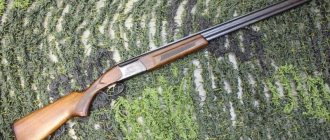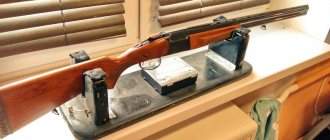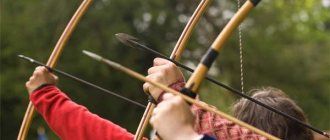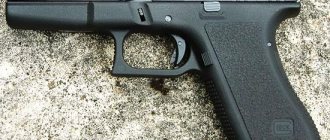The karambit knife, what it is used for, is a virtual thing. Most of those who saw him met him in computer games, where heroes famously rip open the stomachs of opponents with karambits. Karambit is a sickle-shaped knife with a short blade sharpened on the inside of the sickle. This weapon is held with a reverse grip, with the sharp blade facing away from you. The classic karambit has a hole in the handle into which the index finger is inserted in order to make it difficult for the enemy to snatch the knife from his hands.
History of appearance
The word, or more precisely the phrase “karambit” or “karambit” (in English – karambit) means “tiger claw” in Malay.
Classic modern karambit
There is a very exotic legend about the appearance of this weapon. In ancient Malaysia, there was a war between the Javanese and the Minangkbau people. The wise rulers of both nations decided to hold a bullfight instead of a general battle. Each side put up its own bull, and whoever won the bullfight won the war. The Javanese found a huge, ferocious bull and put it into battle. The Minangkbau put up a small buffalo calf to fight. But with karambit knives tied to the horns. The hungry baby, released into the arena, ran to look for the udder under the opponent’s belly and ripped open the bull’s stomach. The Minangbau won. I have questions for the legend:
- What does this have to do with the invention of the knife? To tie it to the horns of a buffalo, the karambit first had to be invented;
- Why a sickle blade? If you tied ordinary short knives, would the result be different?
But let's not quibble, a legend is a legend.
There are other legends that offer their own version of the origin of karambit. One of them connects the invention of this type of weapon with the alleged popularity of cockfighting on the island of Sumatra. Owners of fighting roosters, according to legend, tied miniature sickle-shaped knives to the paws of their roosters. This enhanced the striking capabilities of the birds and allowed them to win battles. Whether such “enhanced armament” of the roosters was legal, or whether the chicken breeders managed to tie the blades unnoticed, the legend is silent. This does not prevent local guides from telling the legend to inexperienced Russian tourists.
Stages of development
A number of serious historians associate the origin of karambit with the appearance on the islands of the Malay Archipelago of a special Indian brass knuckle knife, the bagh nakh. This knife had sharpened spikes and could serve as a prototype for the first karambits. The further spread of the knife throughout Malaysia, and subsequently throughout the world, took place in several stages. The design of the knife no longer requires a ring for the index finger. Varieties of weapons appeared with a ring in the middle of the knife or even without a ring at all. To fix the knife in the hand and prevent it from being pulled out, they began to use a special thickening at the rear end of the handle. Even folding knives appeared, which was unthinkable in the 14th century. Knives with two blades came into use. The blades came out of the fist from both sides: from the index finger and from the little finger. The fighting technique in this case changed. Both attacks from bottom to top and top to bottom became possible. A new surge of interest in weapons of this type occurred in the second half of the 20th century. The authoritative American knife magazine Blade Magazine published a series of materials about karambits. This attracted the attention of knife enthusiasts from all over the world. There has been a new interest in these exotic knives, they have become fashionable and are now famous and popular.
Variations
There are many regional variations of karambit. The length of the blade, for example, can vary depending on the preferences of a particular area or blacksmith. Some replicas do not have finger protection, and some have two blades attached to the handle, one on each side. Traditional types include:
- Kuku Bima: "claw of Bhima" from West Java.
- Kuku Hanuman: "claw of Hanuman" from West Java.
- Kuku Machan: "tiger claw", endemic to Sumatra, from Central Java and Madura.
- Sumbawa Karambit: A larger, stronger karambit designed specifically for combat. From the Sumba Islands.
- Lombok Karambit: A larger, stronger karambit designed specifically for combat. From Lombok
- Lavi Ayam: "chicken claw" created by the Minang community.
In addition, the structure of modern karambits may include peculiar spikes or spurs on the front or back heel of the blade, which can be designed to grab clothing or harness, as well as tear flesh or inject poison, for example, from the leaves of anchar (tree or bush, native to the East Indies or the Malay Archipelago).
Design and technical characteristics
What does karambit look like? Its design is simple. The classic knife does not fold out. It is held with a reverse grip, blade down. The blade, sharpened from the inside of the sickle, passes through the body of the handle and goes into the ring for the index finger. The handle usually consists of two halves placed on the knife plate on both sides. The structure is fastened with copper rivets.
There are structurally alternative karambits.
Some varieties look like this: they have two blades facing the same direction. In this case, the handle is located in the middle of the knife. Cutting blows with such weapons can be applied both from bottom to top and from top to bottom. This diversifies the combat capabilities of the knife.
Sometimes a design feature is that the finger ring is placed in the middle of the knife, on the border between the blade and the handle. Moreover, you can insert your index finger into the ring, not necessarily. You can use your little finger. This increases the number of possible combat uses of the knife.
The length of the blade of a traditional karambit knife is from 3 to 10 cm. The handle is 12-15 cm.
A modern, now classic, version of the design of a curved karambit knife was developed by the American Steve Tarani, and mass production was launched by Strider Knives, Inc. Of the traditional knives, the closest thing to a modern knife is the Lavi Ayam - the rooster spur. The length of an American knife is 20 cm, of which 8 are on the blade. The weight of the knife is 156 grams. It’s hard to say what size knives the owners of fighting cocks tied to the paws of their pets on the island of Sumatra, but American roosters with such “spurs” are impressive!
Such a copy can be ordered on Ali Express. Delivery will take a week.
How to do it yourself
You can try to make such a beautiful blade yourself from paper, cardboard, plywood and wood. You will get an exact copy of the blade, as in the popular computer game. It is imperative to perform all actions in order to avoid mistakes.
Create a drawing
Before creating a drawing of a karambit knife, select the model you want to make. Dimensions are taken. If you wish, you can find a ready-made drawing of the blade and print it or trace it along the contours directly on the monitor screen. A simple drawing is drawn on paper on a scale of 1:1. For this, a sheet of thick paper with A4 format will be enough.
Making a knife
Making a popular knife with a drawing is quite simple. Now you need to prepare the materials for the work from which the knife and tools will be made.
From paper
To work you need to prepare:
- several sheets of paper, the color can be any desired; for contrast, the handle can be made in a different color;
- scotch;
- marker;
- pencil;
- scissors and PVA glue or hot melt glue.
Making a blade from paper is done step by step:
- In the drawing, the knife is divided into three parts: the blade, the handle to the ring and the ring.
- Cut out these three parts carefully with scissors.
- To make the handle, fold a sheet of A4 paper in half, then in half again (1/4), and again (1/8) to make a rectangle out of the paper.
- Apply the handle template to the folded paper so that the top of the template is on the top solid part of the fold of the sheet. Trace with a pencil and cut along the contour, without touching the upper solid part of the fold.
- The resulting “book” of eight leaves is glued together. The middle doesn't stick together. It turns out a handle with a bend.
- Glue the handle completely, except for 3 cm along the edge where it joins the blade. This part remains to strengthen the edge.
- To make a knife blade, fold the paper in the same way as in step 3 for the handle.
- The template is traced according to the same pattern as that of the handle and cut out, after adding 2 cm at the wide part for easy joining with the handle.
- Glue the parts except the middle.
- To fasten, take a square sheet of paper, place a thin rod from a pen on the edge and roll the paper along the rod into a thin tube. Twist the tip of the paper and glue it with tape so that everything does not unravel.
- The rod is removed from the resulting structure, the workpiece is smoothed with your fingers and 2 pieces of 10 cm and 5 cm are cut off - these are the fastenings for the blade and handle.
- The blade is connected to the handle using fasteners and glued together.
- For the third part of the ring, form the same structure as in step 10. Only from it the ring is twisted and glued to the handle.
Made of wood
The option of making karambit from wood is complex, it is suitable for those who have skills in working with wood. The type of wood suitable for work is linden. The size of the workpiece should be slightly larger than the future dimensions of the knife. The linden must first be dried; it should not have cracks or holes from knots. To work you will need:
- drills of different sizes;
- chisels of different shapes;
- vice;
- different knives with carbon steel blades.
When making a blade from wood, they use a sketch drawing, as well as their spatial imagination:
- The drawing is transferred to cardboard, a template of three parts is cut out: the main part of the blade and handle and two shaped attachments.
- The template is transferred to a wooden blank and cut out.
- The handle hole is cut with a feather drill or jigsaw.
- The finished parts are glued together with PVA glue and clamped in a vice for a day until dry.
- The last thing to do is sanding until completely smooth.
Coloring
The finished model of the knife can be painted like a real karambit for role-playing. Options are selected at will from the popular computer game, which was mentioned at the beginning of the article Counter-Strike: Global Offensive. Acrylic paints are chosen for painting. They have advantages:
- they do not get dirty and dry quickly;
- paints are harmless.
The most popular blade coloring options:
- Murder and Bloody Web - in black and red;
- Tiger tooth - the blade and ring are painted to resemble the skin of a tiger;
- Gamma wave – black malachite color, and many others.
Using the skins system, it’s easy to stylize this blade.
Gamma wave
Bloody Web
Tiger tooth
Types of classic specimens
For the sake of marketing promotion or based on the results of historical research, several varieties of real traditional concave karambits are distinguished:
Minang
The name Minang contains part of the name of the people among whom this type of knife became widespread - Minangbau.
Classic Minang resembles a sickle
The crescent shape of the blade resembles the progenitor of this type of bladed weapon - the agricultural sickle. This is one of the most ancient types of weapons of this type. This is what is depicted on the pedestal of the 14th century statue of the then ruler of the Minangbau, depicted in the form of the god Bhairav, one of the most ferocious incarnations of Shiva. It has a geometry quite traditional for such knives with sharpening of the inner side of the blade and a handle designed for a reverse grip.
Minang Harimau
A specific Sumatran type of knife. There is often an image of a tiger on the hilt, as well as on the scabbard.
According to legend, Minang Harimau knives resemble tiger claws
There is a legend that connects the very invention of karambit with the idea of imitating tiger claws. It is unknown how true this legend is. Noteworthy is the fact that the nature of the movements of a tiger and a man armed with a karambit knife are fundamentally different from each other. The tiger's claws are turned towards itself, and it makes a fighting movement with its paw from top to bottom, from the periphery to the center. A man with a knife moves away from himself, from bottom to top, using extensor muscles. The difference is significant, but such a legend exists.
Taji
Javanese type of knife.
Taji. Originates from the island of Java
It is striking that the Taji is the most curved of the traditional Malay knives. Its blade is bent more than 90 degrees; in fact, it is not directed away from the handle, but straight up. When struck, such a knife is drawn into the human body. It causes particularly severe injuries. The real murder weapon.
A metal ring is used for the index finger.
Besar
Besar is a combat knife from the island of Java. It is characterized by a heavy, elongated blade.
Of all the varieties of traditional Malaysian knives, the Javanese besar is the most similar to a classic hunting knife.
Besar. Javanese variety of karambit
The besar has a wide and relatively thick steel blade that is quite wide and straight. The handle is bent in the direction opposite to the butt, which makes the knife similar to other varieties of this traditional weapon. There is no guard.
Burung
Burung is translated from Malay as “bird”. The blade is shaped like a bird's beak.
Burung. Blade in the shape of a bird's beak
Burung differs from other knives in the series by its shape. Its short blade is located almost perpendicular, and sometimes strictly perpendicular to the handle. This is a specifically military weapon, which no longer resembles an agricultural sickle at all. Evolution has come a long way. There are cases when the butt of the burung is also sharpened, and the weapon becomes double-sided. With this knife you can cut from the bottom up, or from the top down.
Lavi Ayyam
A small knife in the shape of a classic cockspur, which corresponds to one of the legends about the origin of this type of weapon.
Karambit Lavi Ayam “Cock Spur”
Supporters of this point of view believe that the first knives of this kind were made in imitation of a cock's spur. They are not embarrassed by the fact that the rooster’s spur is located behind its leg, and the knife fighting technique involves the fighter’s actions in front of him. However, the shape of this traditional Sumatran knife really resembles a spur. Only a sharpened spur.
Kuku makhan
Kuku Makan literally means "Great Tiger's Claw" in Malay.
Kuku Mahan has a smoother blade curve
Compared to other varieties, it has a smoother blade curve. This variety is a little more similar than others to a traditional household or combat knife. Its crescent-shaped blade has a slightly smaller curve than other models. This makes the kuku makhana look a little more traditional.
The main use of this and all other known models of karambits remains as a souvenir.
Why do we need drawings of knives from CS:GO?
It was in CS:GO that knives became very diverse in the number of shapes and colors. You can literally find a blade for every taste. Surely many would like to have a real karambit in their favorite skin, but which would be made of real metal. Thanks to CS:GO, this opportunity has appeared. Souvenir products can satisfy any wishes, and if you have drawings of knives from CS:GO, you can try to make them yourself, using materials like plastic, metal or cardboard. A correctly made replica will allow you to enjoy for a long time just looking at it and remembering the work done.
Advantages and effectiveness of karambit
Ancient karambits could usually be made from a used sickle. The presence of a sickle in the house of almost every peasant is the main advantage and the basis for the popularity of this weapon. It was done according to tradition, the drawing was not used.
As for combat use, karambit is poorly suited for delivering piercing blows, the main ones in knife fighting. Cutting blows with a classic karambit in a reverse grip are applied to the opponent’s stomach area when the fighters are very close.
Karambit is the weapon of last resort. It can only be successfully applied to an unarmed enemy. A fighter armed even with only a bayonet-knife will not allow a karambit cut to his stomach. The bayonet is excellent for piercing strikes with an outstretched hand, and the enemy will not be able to get to the required distance to deliver a cutting blow.
Miniature karambit. Blade – 2.5 cm
Previously, additional effectiveness of this weapon was given by the fact that in many cases the knife blade was smeared with poison before combat use. Poisons of plant and animal origin were widely known in Southeast Asia. Many of them, including very potent ones, were extracted by local residents from snakes, spiders, poisonous fish and plants. Even a small portion of poison introduced into the human body through a knife wound led to death. A poisoned knife is much stronger than just a knife, and this was widely used in Malaysia.
The use of such weapons in Russia has its own specifics. Russia is a mostly northern country, it’s cold here, so dress warmly. And it is unlikely to cause serious damage to an enemy through a sheepskin coat, overcoat or padded jacket with a short knife. Karambit is a summer weapon for good weather.
Manufacturing
So, how can you make a fairly reliable imitation with your own hands?
Sawing blanks
Dear reader, do you have a jigsaw? Yes? Great, put it aside and forget about it.
There are two ways to cut a wooden blank of complex shape from plywood 4–12 mm thick:
- Hand jigsaw;
- An improvised cutter, which can be a stationary circular saw or an angle grinder with a saw blade installed. In the latter case, the workpiece is securely fixed with a clamp.
Attention: if you are going to work with a grinder converted into a saw, do not forget about safety glasses and be extremely careful. In particular, you can put the tool on the table only after the disk has completely stopped.
The holes in the handle are selected with a ballerina or a feather drill of the appropriate diameter.
The hand jigsaw is still in demand.
Gluing
Universal PVA glue is quite suitable for it. The price of a small tube that we will need will be no more than 20-30 rubles.
The pieces will have to be glued and dried under pressure:
| Stage | Actions |
| 1 | Apply a layer of glue to the contacting sides of the workpieces |
| 2 | Clamp the product with a wooden clamp or metal vice, under the cheeks of which are placed scraps of plywood |
| 3 | Remove any squeezed out glue as far as a clamp or vice will allow. When it sets, it will be more difficult to get rid of drips |
Grinding
It can be done:
- On a belt or disc sander;
- On sandpaper;
Attention: emery grinds down soft wood very quickly. The workpiece is pressed against it with minimal pressure.
- By hand, on a block covered with sandpaper.
Do not strive for the sharpness of the blade: plywood ground to a razor sharpness will quickly break.
It is better not to sharpen the edges of the blade, but to slightly round it.
Impregnation
It is best to impregnate the blade with bakelite wood varnish to protect it from water. If for some reason it is not available, ordinary drying oil will do just fine. For deeper penetration into the veneer, it is preheated in a water bath.
Painting
Alkyd enamel PF-115 fits well on bakelite varnish. A charcoal black or ball (gray) color will look great on a knife. Over drying oil, plywood can only be painted with oil paint for exterior use.
To give a matte texture, after the paint has dried, the blade is treated with sandpaper - zero.
Sanding gave the painted surface a matte texture.
Instructions for use
Planing a branch or cutting sausage with karambit is difficult and inconvenient. A very specific grip makes it difficult to use in everyday life. It makes sense to use karambit only if there is no other knife. When solving everyday problems with such a knife, you should not insert your index finger into the ring. The index finger should be kept closer to the blade, and the little finger should be placed closer to the ring, without inserting the finger into it. The risk of someone snatching the knife from you while you are cutting sausage is small. Perhaps this risk can be neglected.
The reverse grip and sharpening along the inner arc of the blade make the combat use of karambits a difficult task.
Piercing blows with a karambit knife are not applied, because the knife comes out of the fist from the side of the little finger, and it is not possible to deliver a piercing blow with the little finger forward, it is inconvenient. But even if you managed to contrive and deliver such a blow, the outer, unsharpened side of the knife arc will come into contact with the enemy’s body. Piercing blows are not for karambit. Its combat use involves the use of cutting blows.
Folding modern karambit Blackhawk Garra II
When cutting blows with a reverse grip, it is mainly the extensor muscles of the arms that work. They are much weaker than the biceps flexors. They need to be specially trained for karambit fighting techniques. Of course, to study this technique it would be good to go to Sumatra and study at one of the schools there. But in recent years, courses in karambit studies can be found in our country. If for some mysterious reason someone prefers this exotic weapon to a standard Kalashnikov bayonet knife, then it makes sense to enroll in these courses.
Possession technique
Of course, at first you want to take the karambit with the usual straight grip, there are even models that require just such a grip, but all the advantages described above can only be applied with a traditional grip. This type of weapon is included in the standard ammunition of some types of troops in different countries of the world, as well as rapid reaction groups. Military personnel who use karambit undergo special training to learn how to use this non-standard knife. It should be noted that without such training it is unlikely that you will be able to use the weapon, and you can even harm yourself.
Is karambit considered a cold weapon in Russia?
The distinctive features of edged weapons are listed in the state standard GOST R 51500-99. According to this standard, all non-folding knives with a blade longer than 9 cm are considered edged weapons. This is the first thing people learn from this GOST. But there is one more point that gives every reason not to classify karambits as edged weapons, but to consider them household knives. Knives that GOST considers to be edged weapons must have a guard to protect the hand during stabbing blows. Piercing blows are not the native element of karambit; they do not have a guard. This means that karambits are household knives. In accordance with the “Weapons Law” in Russia, this is generally accepted.
Butterfly Knife
The butterfly knife is one of the most popular knives in the game, because it has an interesting appearance, original animations, and some of the skins on it look very good.
Appearing after Operation Breakthrough, he was incredibly in demand. Now it greatly contributes to the variety of knives in the game, since many players like this knife, but there are other, no less interesting options. Taking a drawing of a butterfly knife from CS:GO, you can try to recreate it in the form in which it is present in the game, including its skin. Due to its popularity, it will not be difficult to discover the scheme, or you can use a ready-made option. For any fan of the game, a real butterfly knife will be a wonderful gift for any occasion.











